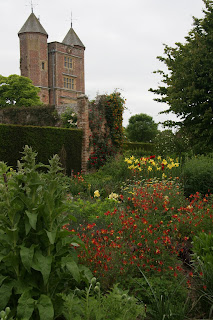As I stared at the old Mountbatten Juniper at the foot of my garden, a few words of poet and novelist, Vita Sackville-West, came to mind. An aristocratic celebrity of the nineteen-thirties with an exuberant lifestyle, Vita, besides being the garden columnist for The Observer newspaper, was the creator of one of Britain Kent London
Travelling to Sissinghurst is something of a pilgrimage for gardeners, and although it took a hastily coordinated subway, train, and country cab ride to reach the property, which is located in the heart ofKent
Travelling to Sissinghurst is something of a pilgrimage for gardeners, and although it took a hastily coordinated subway, train, and country cab ride to reach the property, which is located in the heart of

The castle at Sissinghurst is, in reality, a large Elizabethan mansion, almost derelict when Vita and her husband, Harold Nicholson, bought the place in 1930. Eight years later, the mansion was restored and the impressive gardens they designed and created were opened to the public for the first time. In 1967, it was taken over by The National Trust and is visited each year by both gardeners and lovers of history.
There are actually ten gardens, separated by hedges, arches, and moss covered walls draped with climbing roses. Each one is unique and secluded, but all share the peace and tranquility of the gentle countryside that surrounds the property. They are a joy to explore. Turn a corner and there’s gorgeous white wisteria in full bloom dominating a red brick wall. It only blooms for a couple of weeks in late May and for once I was so lucky to be in the right place at the perfect time to see it.
Pass through an archway and you’re in a walled garden with every imaginable perennial bordering a soft green lawn. In the rose garden, I discovered shrub roses with their canes cleverly turned down into the soil. The tips had been encouraged to take root, resulting in profusely blooming hoops. There’s a nuttery, a lime walk, a moat and a herb garden. So much to see and absorb, but there was more. I was able to climb the 78 spiral stone steps of the restored tower that dominates the garden and view the beauty from an entirely different perspective.
Being there on a sunny afternoon in springtime, the garden in full bloom, water flowing softly, and songbirds warbling away, it wasn’t an easy place to leave, but I hope to return some day, perhaps next spring.
Meanwhile, the spirit of Vita lives on in her words that describe the bond between those who visit her masterpiece: "These mild gentlemen and women who invade one's garden after putting their silver token into the bowl . . . are some of the people I most gladly welcome and salute. Between them and myself a particular form of courtesy survives, a gardener's courtesy, in a world where courtesy is giving place to rougher things."
I will never have a garden anywhere near as grand as the one at Sissinghurst, but already, what I learned from Vita Sackville-West is beginning to influence the way I think about at my own modest garden. I like to think I share something with that remarkable, visionary woman. As I stood there at the foot of my garden, saw in hand. I could hear her words. She said: "The true gardener must be brutal . . . and imaginative for the future." The scraggly old juniper simply had to go.
No comments:
Post a Comment